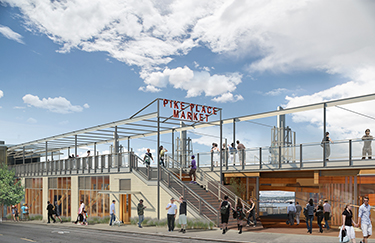|
Subscribe / Renew |
|
|
Contact Us |
|
| ► Subscribe to our Free Weekly Newsletter | |
| home | Welcome, sign in or click here to subscribe. | login |
Architecture & Engineering
| |
 |
November 20, 2014
We still have a lot to learn from Pike Place Market
The Miller Hull Partnership

Miller
|
The mixed-use project has gained an elevated position in the world of urban designers, planners, architects, social thinkers, community activists and political leaders.
While it is true that the mixed-use typology is a big improvement over the early modern view that buildings should be containers for separate functions so as not to suffocate the others, they are becoming somewhat predictable and are not necessarily the panacea for urban problems. We only need to drive down Broadway on Capitol Hill or through Belltown in Seattle to see how repetitive and predictable recent mixed-use projects have become.
Our most treasured cities are ones that quietly weave together a rich and complex pattern of uses and activities. A fabric of interwoven uses typically evolves over many years, changing over time in response to changing needs, economic forces and zoning code modifications.
Since the mixed-use building is a function of its environment, it would not exist without the city that nurtures it. So when we think about how mixed-use buildings are contributing to our urban experiences, we need to look closely at the cities that give rise to them.
MarketFront complex
Seattle’s central downtown can be characterized as monolithic — without the sense of a vibrant and complex urban environment.
Miller Hull is currently working on the expansion of Pike Place Market. My experience on this project has made me acutely aware of the lack of vitality in the city core, and reminds me how the humble market provides a remarkable example of a successful urban mixed-use experience.
The project is located on the only market site yet to be developed, at the foot of the Desimone Bridge between Western Avenue and the Alaskan Way Viaduct, currently a surface parking lot that has sat vacant since an original building located there was destroyed by fire 30 years ago.
The maze of the market is best known for its colorful stalls and lively mix of restaurants and shops. It also provides low-income and senior housing, and invaluable social services such as a medical clinic, food bank and day-care center.
In adding to this historic hub cobbled together over the last century, the architectural expression of the new site — which will include more market space, a brewpub, senior housing and social services — respects that history and provides the central connection point to engage with the new Overlook Walk being designed by New York City firm James Corner Field Operations.
Known as the MarketFront, this new complex will connect to the waterfront with an extended public space through and over the market site to the city.
A sense of discovery
A lack of meaningful and engaging human experiences pervades many of our downtown streets, which is one reason it is so exciting to enter the realm of Pike Place Market. We know that the city cannot — and should not — replicate the market everywhere, but some of the delight of that rich environment can be successfully applied to the larger urban context.
The “market model” is more organic and less formulaic than our typical blocks, with a greater mixture of overlapping uses and linked experiences. The market’s mixed-use buildings have a high degree of spatial variety, options for user engagement and a sense of both indoor and outdoor experiences.
I always enjoy walking from Union Street to the DeLaurenti Specialty Food & Wine store through the 98 Union Arcade building (designed by Olson/Walker Architects), where one can look down into the Pike Brewery, pass openings out to First Avenue, arrive in a large vertical atrium and then move up a half-flight of stairs to the main arcade level.
There is always a sense of discovery in this short one-block experience, which the Miller Hull design team is aiming to capture in the market expansion, particularly with a covered breezeway/arcade connecting Western Avenue to a pedestrian promenade at the west edge of the project.
The expansion is slated to break ground in 2015.
Making more of alleys
The market’s alleys and through-block pedestrian paths can be replicated to a greater extent downtown. There are some examples around, like Post Alley beyond the market in the Harbor Steps area and the mid-block Alley24 project in South Lake Union, but we need to make more of alleys as public spaces.
Seattle’s alleys are powerful visual and sensory experiences that just need new pavement, lighting and functional overlapping program uses where loading and services coexist with pedestrians to bring them into the public realm.
These pedestrian corridors can enliven a mixed-use project by creating new permeable elevations — that is, the backs could become secondary fronts and link to new paths through the city. Linked spatial experiences are vital to creating a more vibrant city.
Miller Hull is working with the James Corner Field Operations team to create a series of linked habitable containers moving from the market to the waterfront.
Two structures, currently with the generic names — buildings B and C — will provide respite activities on the journey from the market down to the Elliott Bay Promenade. Building B will have a retail pop-up hall fronting on Corner’s beautiful Overlook Walk.
Prevailing city planning theories acknowledge that no building within an urban situation stands alone. But architects today often forget that a building is a link in the urban chain, and as such, must respond to a city’s needs as much as to its own.
The external demands that act on the urban environment have an equal, if not stronger, influence on the individual buildings than its internal demands. In fact, looking at the long term, isn’t it more rational for buildings not to have a finite-fixed program, and instead be viewed as multivalent armatures for adaptation and flexible use?
Then we can plan and create true mixed-use projects that create successful, coherent and lively urban frameworks that endure.
David Miller is a founding partner of The Miller Hull Partnership. He also is chair of the Department of Architecture at the University of Washington.
Other Stories:
- Mack Urban's tower first out of the blocks
- Some of the biggest changes — that you won't see
- The task: make a new waterfront, but keep it real
- Art takes center stage on new waterfront
- Putting a whole new light on the waterfront
- Thousands of public comments help shape the design



